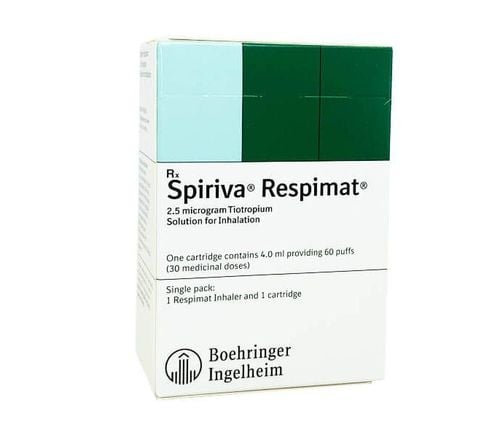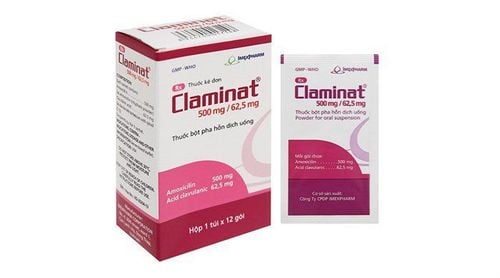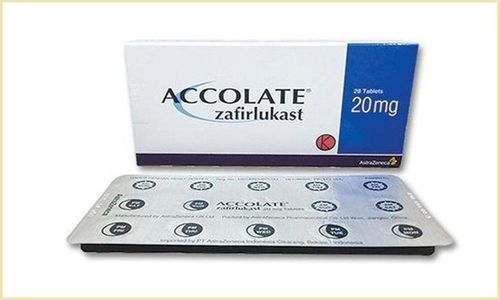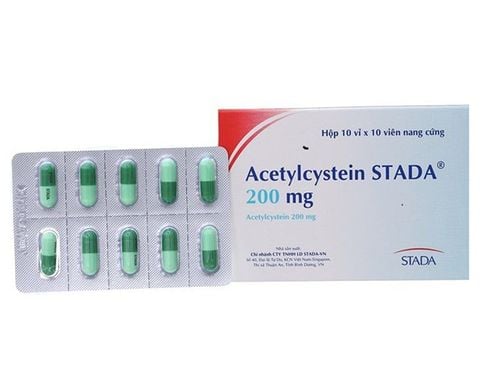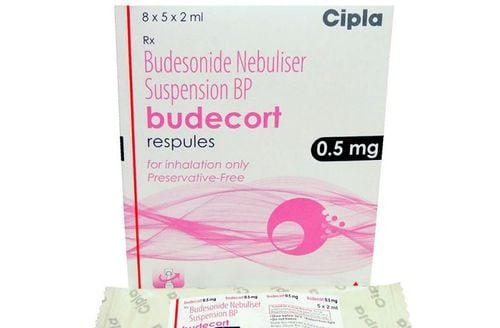This is an automatically translated article.
Currently, chronic obstructive pulmonary disease (COPD) is the 9th leading cause of death worldwide, accounting for more than 3% of all deaths. Patients with COPD are not only more susceptible to pulmonary, musculoskeletal, and psychological diseases, but also have more hospitalizations and poor quality of life. Therefore, the use of bronchodilators has contributed to reducing these disease burdens.
1. What is a bronchodilator?
Bronchodilator is a medicine that dilates and opens the airways or bronchi in the lungs. Taking a bronchodilator when the airways are constricted or narrowed due to respiratory conditions such as asthma and chronic obstructive pulmonary disease (COPD), which causes bronchospasm, helps to dilate or widen muscles in the airways, making it easier for the patient to breathe.
Based on pharmacochemistry, bronchial smooth muscle relaxants are classified as beta 2 agonists, anticholinergics and finally xanthine derivatives. These bronchodilators all have the same effect of opening up the airways (or airways), but they act on different receptors in the body. Specifically as follows:
Bronchodilator beta-2 agonists stimulate beta receptors in the airways. This type of bronchial smooth muscle relaxant improves airflow and relieves symptoms such as shortness of breath. Anticholinergic bronchodilators block the action of acetylcholine. Acetylcholine is a chemical released by nerves that can lead to tightening of the bronchial tubes. By blocking the action of this chemical, anticholinergic bronchial smooth muscle relaxants cause the airways to relax and open. Bronchial smooth muscle relaxants of xanthine derivatives such as theophylline (in capsule, tablet, or liquid form) also relax smooth muscle in the airways, but how they work is unclear. As a result, doctors rarely prescribe theophylline because many patients experience significant side effects.
2. What types of bronchial smooth muscle relaxants are available?
There are two main types of bronchial smooth muscle relaxants based on their duration of action. Short-acting and long-acting bronchodilators treat various respiratory conditions and are usually sold by prescription.
2.1. What are short-acting bronchodilators?
Bronchodilators are commonly used to treat conditions such as asthma and emphysema. Doctors often refer to these short-acting bronchodilators as rapid-acting bronchodilators. Short-acting bronchodilators are used to treat symptoms that come on suddenly and require urgent treatment, such as wheezing, shortness of breath, and chest tightness.
The effects of short-acting bronchial smooth muscle relaxants are usually rapid, evident within minutes. Although short-acting bronchial smooth muscle relaxants have rapid action, the duration of action is usually short, and the therapeutic effect usually lasts only 4 to 5 hours.
Common short-acting bronchodilators include:
Albuterol (Ventolin HFA, ProAir HFA, Proventil HFA); Levalbuterol (Xopenex HFA); Pirbuterol (Maxair).
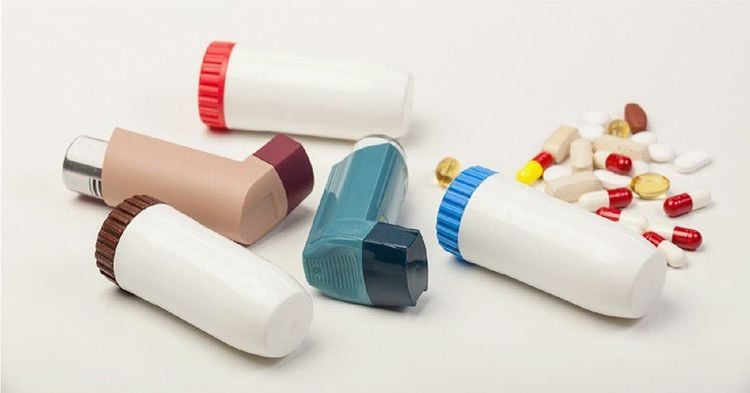
Tác dụng của các thuốc giãn cơ trơn phế quản tác dụng ngắn hạn thường nhanh chóng
2.2. What are long-acting bronchodilators?
According to the American Academy of Allergy, Asthma, and Immunology, if a patient requires a daily fast-acting bronchodilator, it means that the patient is not having good control of the disease's symptoms and has Long-acting bronchodilator smooth muscle relaxants may be required.
Long-acting bronchial smooth muscle relaxants are not as fast-acting as short-acting bronchodilators and are not used to treat acute or sudden symptoms of respiratory diseases caused by inhalation. However, the effects of long-acting bronchial smooth muscle relaxants usually last for 12 to 24 hours and are recommended for daily use to prevent respiratory symptoms from developing.
Common long-acting bronchodilators include:
Salmeterol (Serevent); Formoterol ( Perforomist ); Aclidinium (Tudorza); Tiotropium (Spiriva); Umeclidinium (Incruse).
3. How to use bronchial smooth muscle relaxants?
Selecting the correct bronchodilator and how to use it is important to ensure that the user is receiving the correct dose to achieve the effective treatment of chronic obstructive pulmonary disease (COPD). The best type of bronchodilator to take may depend on a person's age, economic status, level of consciousness, and including personal preference.
Devices containing bronchial smooth muscle relaxants that are suitable for the user's ability will provide the highest treatment effect. Inhaled bronchodilators are preferred because they allow the drug to reach the lungs quickly, with immediate effects. In addition, inhaled bronchial smooth muscle relaxants have the advantage that only small doses are required, resulting in fewer systemic side effects than when people take bronchial smooth muscle relaxants. drink.
Even so, it is important to understand how to use a bronchodilator properly to ensure that it reaches the lungs as much as possible. The most common ways to use bronchial smooth muscle relaxants include:
MDI inhaler A metered dose inhaler (MDI) is a small tube containing a bronchial smooth muscle relaxant that has a pressurized device. The MDI inhaler device releases a bronchial smooth muscle relaxant when the user presses down on the canister. Thanks to the action of the propellant in the MDI inhaler and the force of inhalation by the body, a dose of the bronchodilator smooth muscle relaxant enters the lungs. If a patient doesn't coordinate their MDI effectively, some medications can stay in the back of the throat or mouth instead of the lungs, affecting the outcome of chronic obstructive pulmonary disease (COPD).
Nebulizer Nebulizers take bronchial smooth muscle relaxants in liquid form and turn them into aerosols.
Dry powder inhaler The bronchodilator in a dry powder inhaler has no propellant and exists in powder form.
Soft mist inhalers Some bronchial smooth muscle relaxants are available in soft mist inhalers in aerosol form. The soft mist inhaler delivers a cloud of aerosols into the lungs without the need for a propellant. Research published in the International Journal of Chronic Obstructive Pulmonary Disease indicates that aerosolized bronchial smooth muscle relaxants from a soft mist inhaler move more slowly and last longer than aerosols from an MDI. , thus delivering more medicine to the lungs and less to the back of the throat.
In addition, there are forms of bronchial smooth muscle relaxants including tablets and syrups.
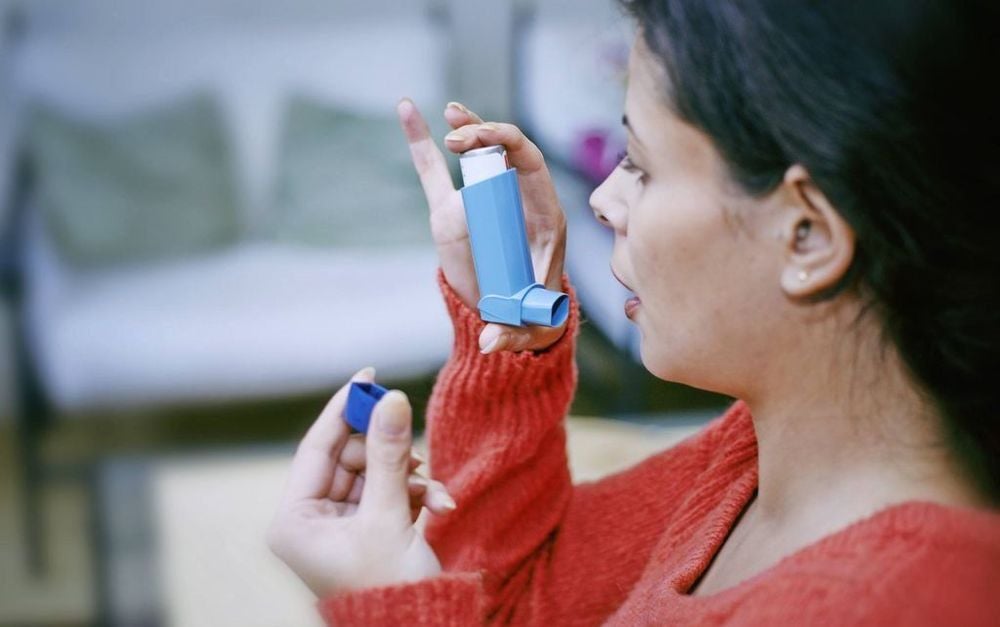
Thiết bị ống hít MDI giải phóng thuốc giãn cơ trơn phế quản khi người dùng ấn xuống ống đựng thuốc
4. What is the role of bronchial smooth muscle relaxants in the treatment of COPD?
Chronic obstructive pulmonary disease (COPD) is the cause of a large socioeconomic burden in Asia with an estimated overall prevalence of 6.3% across the nine Asia-Pacific territories. However, bronchodilator smooth muscle relaxants have had very little research on the adequacy of pharmaceutical care for the treatment of chronic obstructive pulmonary disease (COPD). To identify and analyze potential problems in the use of bronchial smooth muscle relaxants and to improve the quality of optimal drug therapy, several population-based studies have been conducted to evaluate the bronchial smooth muscle relaxant prescribing model, assessing change over time and in different healthcare services.
The Global Initiative for Chronic Obstructive Pulmonary Disease (GOLD) Guidelines recommend that bronchodilator smooth muscle relaxants are the primary approach to managing COPD. Bronchodilators can be used by inhalation or by mouth. In terms of efficacy plus safety, inhaled bronchial smooth muscle relaxants are more recommended than oral bronchodilators. Furthermore, inhaled long-acting bronchodilators are more convenient and more effective than inhaled short-acting bronchodilators.
Several researchers have explored the use of bronchial smooth muscle relaxants in COPD patients in real clinical settings and compared compliance with guidelines showing: “There is a difference in efficacy treatment across geographies and time zones around the world”. Along with that, previous research has also shown that health care providers have a clear impact on care models for a variety of diseases, including chronic obstructive pulmonary disease. calculation (COPD).
5. What side effects may be encountered when using bronchodilator smooth muscle relaxants?
Similar to most drugs, a person may experience unwanted effects from bronchodilator smooth muscle relaxants. The severity of unwanted effects sometimes depends on the dose of the drug the person receives. Specifically, generally the higher the dose taken, the more likely it is to develop side effects. However, side effects are still possible with small doses of bronchodilator smooth muscle relaxants. In addition, the risk of adverse effects with the use of bronchodilators can also vary depending on whether the bronchodilator is a beta 2 agonist or an anticholinergic. .
Possible side effects when patients use bronchodilator smooth muscle relaxants include:
Increased heart rate; Trembling, feeling shaken, anxious; Cough, dry mouth, nausea; Headache; Low blood potassium. In addition, bronchial smooth muscle relaxants can also cause opposite effects (reverse reactions in some situations) and worsen bronchial smooth muscle spasms or lead to bronchospasm. strong management. Allergic reactions can also occur with bronchodilator smooth muscle relaxants leading to symptoms such as rash, difficulty breathing, ... Therefore, using bronchodilator smooth muscle relaxants should be prescribed by a doctor and When detecting symptoms that are suspected to be side effects of the drug, immediately go to the hospital for timely treatment.
Please dial HOTLINE for more information or register for an appointment HERE. Download MyVinmec app to make appointments faster and to manage your bookings easily.




